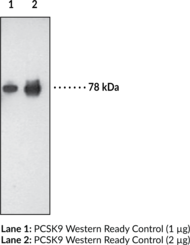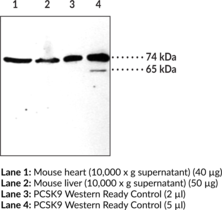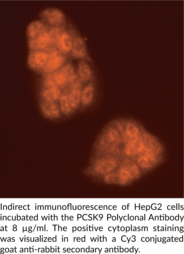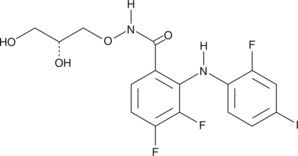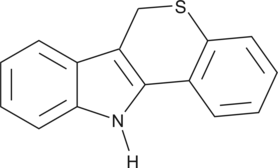Cayman
Showing 34201–34350 of 45550 results
-
PCNA-I1 is an inhibitor of proliferating cell nuclear antigen (PCNA) that binds to PCNA trimers (Kd = 0.41 µM) and dose-dependently reduces the level of PCNA associated with chromatin in PC3 cells.{43201} It preferentially inhibits growth of a variety of human and mouse cancer cell lines (IC50s = 0.05-0.3 µM) over non-transformed cells (IC50s = 0.99-2 µM). PCNA-I1 leads to an accumulation of cells in the G1 phase during the first 24 hours of incubation and halts the cell cycle in the S and G2/M phases by 72 hours following treatment. It also reduces tumor growth in an LNCaP prostate cancer mouse xenograft model when administered at a dose of 10 mg/kg, five days per week, for two weeks.{43202}
Brand:CaymanSKU:20454 -Available on backorder
PCNA-I1 is an inhibitor of proliferating cell nuclear antigen (PCNA) that binds to PCNA trimers (Kd = 0.41 µM) and dose-dependently reduces the level of PCNA associated with chromatin in PC3 cells.{43201} It preferentially inhibits growth of a variety of human and mouse cancer cell lines (IC50s = 0.05-0.3 µM) over non-transformed cells (IC50s = 0.99-2 µM). PCNA-I1 leads to an accumulation of cells in the G1 phase during the first 24 hours of incubation and halts the cell cycle in the S and G2/M phases by 72 hours following treatment. It also reduces tumor growth in an LNCaP prostate cancer mouse xenograft model when administered at a dose of 10 mg/kg, five days per week, for two weeks.{43202}
Brand:CaymanSKU:20454 -Available on backorder
PCNA-I1 is an inhibitor of proliferating cell nuclear antigen (PCNA) that binds to PCNA trimers (Kd = 0.41 µM) and dose-dependently reduces the level of PCNA associated with chromatin in PC3 cells.{43201} It preferentially inhibits growth of a variety of human and mouse cancer cell lines (IC50s = 0.05-0.3 µM) over non-transformed cells (IC50s = 0.99-2 µM). PCNA-I1 leads to an accumulation of cells in the G1 phase during the first 24 hours of incubation and halts the cell cycle in the S and G2/M phases by 72 hours following treatment. It also reduces tumor growth in an LNCaP prostate cancer mouse xenograft model when administered at a dose of 10 mg/kg, five days per week, for two weeks.{43202}
Brand:CaymanSKU:20454 -Available on backorder
PCPr is a phencyclidine (PCP)-derived compound which is the propyl analog of the psychoactive compound eticyclidine. It is a known drug of abuse.{19963} The physiological and pharmacological characteristics of this compound have been poorly studied. This product is intended for forensic and research applications.
Brand:CaymanSKU:9001362 - 10 mgAvailable on backorder
PCPr is a phencyclidine (PCP)-derived compound which is the propyl analog of the psychoactive compound eticyclidine. It is a known drug of abuse.{19963} The physiological and pharmacological characteristics of this compound have been poorly studied. This product is intended for forensic and research applications.
Brand:CaymanSKU:9001362 - 5 mgAvailable on backorder
PCPr is a phencyclidine (PCP)-derived compound which is the propyl analog of the psychoactive compound eticyclidine. It is a known drug of abuse.{19963} The physiological and pharmacological characteristics of this compound have been poorly studied. This product is intended for forensic and research applications.
Brand:CaymanSKU:9001362 - 50 mgAvailable on backorder
Immunogen: Purified human recombinant PCSK9 • Host: Mouse • Clone: 15A6 • Isotype: IgG1 • Species Reactivity: (+) Human recombinant PCSK9 • Application: WB
Brand:CaymanSKU:10218- 1 eaProprotein convertase subtilisin kexin 9 (PCSK9) is a member of the subtilisin serine protease family with an important role in lipoprotein metabolism.{13178} Gain-of-function mutations in the PCSK9 gene are associated with autosomal dominant hypercholesterolemia which is characterized by an increase in low-density lipoprotein (LDL) cholesterol levels.{13158} PCSK9 overexpression in wild-type mice doubles the plasma total cholesterol, possibly through accelerated LDL receptor degredation.{13178,13176} PCSK9 mRNA is detected in various tissues such as liver, kidney, lung, spleen, jejunum, ileum, colon, and muscle with the highest expression in the liver.{13136} Human PCSK9 precursor is 692 amino acids in length with an estimated molecular weight of 74 kDa. This proprotein is self-cleaved to form a mature protein at around 63 kDa in the Golgi body.{13177}
Brand:CaymanSKU:10218 - 1 eaAvailable on backorder
Immunogen: Purified human recombinant PCSK9 • Host: Mouse • Clone: 15A6 • Isotype: IgG1 • Species Reactivity: (+) Human recombinant PCSK9 • Application: WB
Brand:CaymanSKU:10218- 1 eaAvailable on backorder
PCSK9 is a member of the subtilisin serine protease family with an important role in low-density lipoprotein (LDL) metabolism.{13178} Mutation in the PCSK9 gene is associated with autosomal dominant hypercholesterolemia which is characterized by an increase in LDL cholesterol levels.{13158} PCSK9 overexpression in wild-type mice doubles the plasma total cholesterol, possibly through acceleration of the degradation of the LDL receptor.{13176,13178} PCSK9 mRNA is detected in various tissues such as liver, kidney, lung, spleen, jejunum, ileum, colon, and muscles with the highest expression in the liver.{13136} Human PCSK9 precursor is 692 amino acids in length with an estimated molecular weight of 74 kDa. This proprotein is self-cleaved to form a mature protein of 63 kDa in the Golgi.{13177}
Brand:CaymanSKU:10240 - 1 eaAvailable on backorder
Immunogen: Purified recombinant human PCSK9 • Host: Rabbit· Species Reactivity: (+) Human, mouse, and rat • Application: WB
Brand:CaymanSKU:10240- 1 eaImmunogen: Purified recombinant human PCSK9 • Host: Rabbit· Species Reactivity: (+) Human, mouse, and rat • Application: WB
Brand:CaymanSKU:10240- 1 eaAvailable on backorder
Proprotein convertase subtilisin kexin 9 (PCSK9) is a member of the subtilisin serine protease family with an important role in lipoprotein metabolism.{13178} Mutation in the PCSK9 gene is associated with autosomal dominant hypercholesterolemia which is characterized by an increase in low density lipoprotein (LDL) cholesterol levels.{13158} PCSK9 overexpression in wild-type mice doubles the plasma total cholesterol, possibly through acceleration of the degradation of the LDL receptor.{13176,13178} PCSK9 mRNA is detected in various tissues such as liver, kidney, lung, spleen, jejunum, ileum, colon, and muscle with the highest expression in the liver.{13136} Human PCSK9 precursor is 692 amino acids in length with an estimated molecular weight of 74 kDa. This proprotein is self-cleaved to form a mature protein at around 63 kDa in the golgi.{13177} Cayman’s PCSK9 polyclonal antibody detects mainly the mature form of the protein ranging from 62-66 kDa in tissues and cells such as liver, kidney, and colon cancer cells.
Brand:CaymanSKU:10007185 - 500 μlAvailable on backorder
Immunogen: Synthetic peptide from an internal region of human PCSK9 • Host: Rabbit • Species Reactivity: (+) Human, mouse, and rat • Applications: IF and WB • PCSK9 is a member of the subtilisin serine protease family with an important role in lipoprotein metabolism. Several gain of function mutations in the PCSK9 gene are associated with hypercholesterolemia which is characterized by an increase in LDL cholesterol levels.
Brand:CaymanSKU:10007185- 500 μlAvailable on backorder
Proprotein convertase subtilisin kexin 9 (PCSK9) is a member of the subtilisin serine protease family with an important role in lipoprotein metabolism.{13178} Mutation in the PCSK9 gene is associated with autosomal dominant hypercholesterolemia which is characterized by an increase in low density lipoprotein (LDL) cholesterol levels.{13158} PCSK9 overexpression in wild-type mice doubles the plasma total cholesterol, possibly through acceleration of the degradation of the LDL receptor.{13176,13178} PCSK9 mRNA is detected in various tissues such as liver, kidney, lung, spleen, jejunum, ileum, colon, and muscle with the highest expression in the liver.{13136} Human PCSK9 precursor is 692 amino acid in length with an estimated molecular weight of 74 kDa. This proprotein is self-cleaved to form a mature protein at around 63 kDa in the Golgi.{13177}
Brand:CaymanSKU:10008811 - 500 µlAvailable on backorder
Immunogen: Synthetic peptide from an internal region of mouse PCSK9 • Host: Rabbit • Species Reactivity: (+) Human, mouse, and rat • Applications: IF and WB
Brand:CaymanSKU:10008811- 500 µlAvailable on backorder
Immunogen: Synthetic peptide from an internal region of mouse PCSK9 • Host: Rabbit • Species Reactivity: (+) Human, mouse, and rat • Applications: IF and WB
Brand:CaymanSKU:10008811- 500 µlProtectin conjugates in tissue regeneration 1 (PCTR1) is a specialized pro-resolving mediator (SPM) synthesized from docosahexaenoic acid (DHA; Item No. 90310).{38180} DHA is oxidized to 16S,17S-epoxy-protectin, which is then converted to PCTR1 by glutathione S-transferase.{38180,38178} PCTR1 levels increase during resolution of acute microbial-induced peritonitis in mice.{38179} PCTR1 (30 ng, i.p.) administration 12 hours post-infection increases macrophage numbers and activity and shortens the resolution phase of inflammation by 57%. It also reduces the levels of PGE2 (Item No. 14010), PGD2 (Item No. 12010), and TXB2 (Item No. 19030) in peritoneal exudates.
Brand:CaymanSKU:-Available on backorder
Protectin conjugates in tissue regeneration 1 (PCTR1) is a specialized pro-resolving mediator (SPM) synthesized from docosahexaenoic acid (DHA; Item No. 90310).{38180} DHA is oxidized to 16S,17S-epoxy-protectin, which is then converted to PCTR1 by glutathione S-transferase.{38180,38178} PCTR1 levels increase during resolution of acute microbial-induced peritonitis in mice.{38179} PCTR1 (30 ng, i.p.) administration 12 hours post-infection increases macrophage numbers and activity and shortens the resolution phase of inflammation by 57%. It also reduces the levels of PGE2 (Item No. 14010), PGD2 (Item No. 12010), and TXB2 (Item No. 19030) in peritoneal exudates.
Brand:CaymanSKU:-Available on backorder
Protectin conjugates in tissue regeneration 1 (PCTR1) is a specialized pro-resolving mediator (SPM) synthesized from docosahexaenoic acid (DHA; Item No. 90310).{38180} DHA is oxidized to 16S,17S-epoxy-protectin, which is then converted to PCTR1 by glutathione S-transferase.{38180,38178} PCTR1 levels increase during resolution of acute microbial-induced peritonitis in mice.{38179} PCTR1 (30 ng, i.p.) administration 12 hours post-infection increases macrophage numbers and activity and shortens the resolution phase of inflammation by 57%. It also reduces the levels of PGE2 (Item No. 14010), PGD2 (Item No. 12010), and TXB2 (Item No. 19030) in peritoneal exudates.
Brand:CaymanSKU:-Available on backorder
Protectin conjugates in tissue regeneration 1 (PCTR1) is a specialized pro-resolving mediator (SPM) synthesized from docosahexaenoic acid (DHA; Item No. 90310).{38180} DHA is oxidized to 16S,17S-epoxy-protectin, which is then converted to PCTR1 by glutathione S-transferase.{38180,38178} PCTR1 levels increase during resolution of acute microbial-induced peritonitis in mice.{38179} PCTR1 (30 ng, i.p.) administration 12 hours post-infection increases macrophage numbers and activity and shortens the resolution phase of inflammation by 57%. It also reduces the levels of PGE2 (Item No. 14010), PGD2 (Item No. 12010), and TXB2 (Item No. 19030) in peritoneal exudates.
Brand:CaymanSKU:-Available on backorder
Protein conjugates in tissue regeneration 2 (PCTR2) is a specialized pro-resolving mediator (SPM) synthesized from docosahexaenoic acid (DHA; Item No. 90310).{38180,38178} DHA is oxidized to 16S,17S-epoxy-protectin, which is converted to PCTR1 (Item No. 19064) by glutathione S-transferase and to PCTR2 via γ-glutamyl transpeptidase.{38180} PCTR2 is found in resolving mouse exudate and in both M1 and M2 macrophages differentiated from isolated human monocytes.{38778,38179}
Brand:CaymanSKU:-Available on backorder
Protein conjugates in tissue regeneration 2 (PCTR2) is a specialized pro-resolving mediator (SPM) synthesized from docosahexaenoic acid (DHA; Item No. 90310).{38180,38178} DHA is oxidized to 16S,17S-epoxy-protectin, which is converted to PCTR1 (Item No. 19064) by glutathione S-transferase and to PCTR2 via γ-glutamyl transpeptidase.{38180} PCTR2 is found in resolving mouse exudate and in both M1 and M2 macrophages differentiated from isolated human monocytes.{38778,38179}
Brand:CaymanSKU:-Available on backorder
Protein conjugates in tissue regeneration 2 (PCTR2) is a specialized pro-resolving mediator (SPM) synthesized from docosahexaenoic acid (DHA; Item No. 90310).{38180,38178} DHA is oxidized to 16S,17S-epoxy-protectin, which is converted to PCTR1 (Item No. 19064) by glutathione S-transferase and to PCTR2 via γ-glutamyl transpeptidase.{38180} PCTR2 is found in resolving mouse exudate and in both M1 and M2 macrophages differentiated from isolated human monocytes.{38778,38179}
Brand:CaymanSKU:-Available on backorder
Protein conjugates in tissue regeneration 2 (PCTR2) is a specialized pro-resolving mediator (SPM) synthesized from docosahexaenoic acid (DHA; Item No. 90310).{38180,38178} DHA is oxidized to 16S,17S-epoxy-protectin, which is converted to PCTR1 (Item No. 19064) by glutathione S-transferase and to PCTR2 via γ-glutamyl transpeptidase.{38180} PCTR2 is found in resolving mouse exudate and in both M1 and M2 macrophages differentiated from isolated human monocytes.{38778,38179}
Brand:CaymanSKU:-Available on backorder
Protein conjugates in tissue regeneration 3 (PCTR3) is a specialized pro-resolving mediator (SPM) synthesized from docosahexaenoic acid (DHA; Item No. 90310).{38180,38178} DHA is oxidized to 16S,17S-epoxy-protectin, which is converted to PCTR1 (Item No. 19064) by glutathione S-transferase and to PCTR2 (Item No. 19065) and PCTR3 via peptidases.{38180} PCTR3 is found in infected mouse spleens and resolving exudate as well as isolated human spleen and septic plasma.{38778} It is also found in both M1 and M2 macrophages differentiated from isolated human monocytes.{38179}
Brand:CaymanSKU:-Available on backorder
Protein conjugates in tissue regeneration 3 (PCTR3) is a specialized pro-resolving mediator (SPM) synthesized from docosahexaenoic acid (DHA; Item No. 90310).{38180,38178} DHA is oxidized to 16S,17S-epoxy-protectin, which is converted to PCTR1 (Item No. 19064) by glutathione S-transferase and to PCTR2 (Item No. 19065) and PCTR3 via peptidases.{38180} PCTR3 is found in infected mouse spleens and resolving exudate as well as isolated human spleen and septic plasma.{38778} It is also found in both M1 and M2 macrophages differentiated from isolated human monocytes.{38179}
Brand:CaymanSKU:-Available on backorder
Protein conjugates in tissue regeneration 3 (PCTR3) is a specialized pro-resolving mediator (SPM) synthesized from docosahexaenoic acid (DHA; Item No. 90310).{38180,38178} DHA is oxidized to 16S,17S-epoxy-protectin, which is converted to PCTR1 (Item No. 19064) by glutathione S-transferase and to PCTR2 (Item No. 19065) and PCTR3 via peptidases.{38180} PCTR3 is found in infected mouse spleens and resolving exudate as well as isolated human spleen and septic plasma.{38778} It is also found in both M1 and M2 macrophages differentiated from isolated human monocytes.{38179}
Brand:CaymanSKU:-Available on backorder
Protein conjugates in tissue regeneration 3 (PCTR3) is a specialized pro-resolving mediator (SPM) synthesized from docosahexaenoic acid (DHA; Item No. 90310).{38180,38178} DHA is oxidized to 16S,17S-epoxy-protectin, which is converted to PCTR1 (Item No. 19064) by glutathione S-transferase and to PCTR2 (Item No. 19065) and PCTR3 via peptidases.{38180} PCTR3 is found in infected mouse spleens and resolving exudate as well as isolated human spleen and septic plasma.{38778} It is also found in both M1 and M2 macrophages differentiated from isolated human monocytes.{38179}
Brand:CaymanSKU:-Available on backorder
The dual specific threonine/tyrosine kinase MEK is a key component of the RAS/RAF/MEK/ERK signaling pathway that is frequently activated in human tumors.{6694,16830} PD 0325901 is a potent MEK inhibitor that suppresses phosphorylation of ERK in mouse colon 26 tumors with an IC50 value of 0.33 nM.{16877} Suppression of ERK activation with 1 µM PD 0325901 combined with 3 µM CHIR99021 (a glycogen synthase kinase 3 inhibitor) prevents cell differentiation and sustains self renewal of mouse embryonic stem cells for at least eight passages.{16878}
Brand:CaymanSKU:13034 - 1 mgAvailable on backorder
The dual specific threonine/tyrosine kinase MEK is a key component of the RAS/RAF/MEK/ERK signaling pathway that is frequently activated in human tumors.{6694,16830} PD 0325901 is a potent MEK inhibitor that suppresses phosphorylation of ERK in mouse colon 26 tumors with an IC50 value of 0.33 nM.{16877} Suppression of ERK activation with 1 µM PD 0325901 combined with 3 µM CHIR99021 (a glycogen synthase kinase 3 inhibitor) prevents cell differentiation and sustains self renewal of mouse embryonic stem cells for at least eight passages.{16878}
Brand:CaymanSKU:13034 - 10 mgAvailable on backorder
The dual specific threonine/tyrosine kinase MEK is a key component of the RAS/RAF/MEK/ERK signaling pathway that is frequently activated in human tumors.{6694,16830} PD 0325901 is a potent MEK inhibitor that suppresses phosphorylation of ERK in mouse colon 26 tumors with an IC50 value of 0.33 nM.{16877} Suppression of ERK activation with 1 µM PD 0325901 combined with 3 µM CHIR99021 (a glycogen synthase kinase 3 inhibitor) prevents cell differentiation and sustains self renewal of mouse embryonic stem cells for at least eight passages.{16878}
Brand:CaymanSKU:13034 - 25 mgAvailable on backorder
The dual specific threonine/tyrosine kinase MEK is a key component of the RAS/RAF/MEK/ERK signaling pathway that is frequently activated in human tumors.{6694,16830} PD 0325901 is a potent MEK inhibitor that suppresses phosphorylation of ERK in mouse colon 26 tumors with an IC50 value of 0.33 nM.{16877} Suppression of ERK activation with 1 µM PD 0325901 combined with 3 µM CHIR99021 (a glycogen synthase kinase 3 inhibitor) prevents cell differentiation and sustains self renewal of mouse embryonic stem cells for at least eight passages.{16878}
Brand:CaymanSKU:13034 - 5 mgAvailable on backorder
PD 0332991 is an orally active, selective inhibitor of the cyclin D kinases Cdk4 (IC50 = 11 nM) and Cdk6 (IC50= 16 nM) with no activity against a panel of 36 additional protein kinases.{28137} It has been reported to have antiproliferative activity against retinoblastoma-positive tumor cells, blocking retinoblastoma phosphorylation and inducing G1 arrest at nanomolar concentrations.{28137} PD 0332991 can inhibit the growth of certain ER-positive or HER2-amplified breast cancer cells (IC50s as low as 4 nM) and demonstrates synergy with tamoxifen (Item No. 13258) and trastuzumab, respectively.{28138} PD 0332991 inhibition of Cdk4 activity has been used to demonstrate a role for insulin-activated cyclinD1-Cdk4 signaling in the control of glucose metabolism that is independent of cell cycle progression.{26552}
Brand:CaymanSKU:-PD 0332991 is an orally active, selective inhibitor of the cyclin D kinases Cdk4 (IC50 = 11 nM) and Cdk6 (IC50= 16 nM) with no activity against a panel of 36 additional protein kinases.{28137} It has been reported to have antiproliferative activity against retinoblastoma-positive tumor cells, blocking retinoblastoma phosphorylation and inducing G1 arrest at nanomolar concentrations.{28137} PD 0332991 can inhibit the growth of certain ER-positive or HER2-amplified breast cancer cells (IC50s as low as 4 nM) and demonstrates synergy with tamoxifen (Item No. 13258) and trastuzumab, respectively.{28138} PD 0332991 inhibition of Cdk4 activity has been used to demonstrate a role for insulin-activated cyclinD1-Cdk4 signaling in the control of glucose metabolism that is independent of cell cycle progression.{26552}
Brand:CaymanSKU:-PD 0332991 is an orally active, selective inhibitor of the cyclin D kinases Cdk4 (IC50 = 11 nM) and Cdk6 (IC50= 16 nM) with no activity against a panel of 36 additional protein kinases.{28137} It has been reported to have antiproliferative activity against retinoblastoma-positive tumor cells, blocking retinoblastoma phosphorylation and inducing G1 arrest at nanomolar concentrations.{28137} PD 0332991 can inhibit the growth of certain ER-positive or HER2-amplified breast cancer cells (IC50s as low as 4 nM) and demonstrates synergy with tamoxifen (Item No. 13258) and trastuzumab, respectively.{28138} PD 0332991 inhibition of Cdk4 activity has been used to demonstrate a role for insulin-activated cyclinD1-Cdk4 signaling in the control of glucose metabolism that is independent of cell cycle progression.{26552}
Brand:CaymanSKU:-PD 0332991 is an orally active, selective inhibitor of the cyclin D kinases Cdk4 (IC50 = 11 nM) and Cdk6 (IC50= 16 nM) with no activity against a panel of 36 additional protein kinases.{28137} It has been reported to have antiproliferative activity against retinoblastoma-positive tumor cells, blocking retinoblastoma phosphorylation and inducing G1 arrest at nanomolar concentrations.{28137} PD 0332991 can inhibit the growth of certain ER-positive or HER2-amplified breast cancer cells (IC50s as low as 4 nM) and demonstrates synergy with tamoxifen (Item No. 13258) and trastuzumab, respectively.{28138} PD 0332991 inhibition of Cdk4 activity has been used to demonstrate a role for insulin-activated cyclinD1-Cdk4 signaling in the control of glucose metabolism that is independent of cell cycle progression.{26552}
Brand:CaymanSKU:-PD 0332991-d8 is intended for use as an internal standard for the quantification of PD 0332991 (Item No. 16273) by GC- or LC-MS. PD 0332991 is an orally active, selective inhibitor of the cyclin D kinases Cdk4 (IC50 = 11 nM) and Cdk6 (IC50= 16 nM) with no activity against a panel of 36 additional protein kinases.{28137} It has been reported to have antiproliferative activity against retinoblastoma-positive tumor cells, blocking retinoblastoma phosphorylation and inducing G1 arrest at nanomolar concentrations. PD 0332991 can inhibit the growth of certain ER-positive or HER2-amplified breast cancer cells (IC50s as low as 4 nM) and demonstrates synergy with tamoxifen (Item No. 13258) and trastuzumab, respectively.{28138} PD 0332991 inhibition of Cdk4 activity has been used to demonstrate a role for insulin-activated cyclin D1-Cdk4 signaling in the control of glucose metabolism that is independent of cell cycle progression.{26552}
Brand:CaymanSKU:25421 - 1 mgAvailable on backorder
PD 0332991-d8 is intended for use as an internal standard for the quantification of PD 0332991 (Item No. 16273) by GC- or LC-MS. PD 0332991 is an orally active, selective inhibitor of the cyclin D kinases Cdk4 (IC50 = 11 nM) and Cdk6 (IC50= 16 nM) with no activity against a panel of 36 additional protein kinases.{28137} It has been reported to have antiproliferative activity against retinoblastoma-positive tumor cells, blocking retinoblastoma phosphorylation and inducing G1 arrest at nanomolar concentrations. PD 0332991 can inhibit the growth of certain ER-positive or HER2-amplified breast cancer cells (IC50s as low as 4 nM) and demonstrates synergy with tamoxifen (Item No. 13258) and trastuzumab, respectively.{28138} PD 0332991 inhibition of Cdk4 activity has been used to demonstrate a role for insulin-activated cyclin D1-Cdk4 signaling in the control of glucose metabolism that is independent of cell cycle progression.{26552}
Brand:CaymanSKU:25421 - 500 µgAvailable on backorder
PD 082106 is an inhibitor of FMS-related tyrosine kinase 3 (FLT3; IC50 = 0.015 µM, respectively) and a derivative of indirubin (Item No. 14155).{18155} It is selective for FLT3 over Met, Ron, EGFR, and the insulin receptor (IC50s = >10 µM for all) but does inhibit DRAK2 (IC50 = 0.62 µM), as well as VEGFR2 and Aurora A (IC50s = 1.53 and 1.27 µM, respectively).{18155,46931} PD 082106 inhibits proliferation of A549 lung, SNU-638 stomach, HT-1080 fibrosarcoma, HL-60 leukemia, and MCF-7 breast cancer cells with IC50 values of 13, 2.1, 3.4, 89, and 9 µM, respectively, but does not inhibit proliferation of Col 2 colon cancer cells.{46932} It also inhibits proliferation of (IC50 = 5.1 µM), and induces apoptosis in, K-Ras-transformed RK3D rat kidney epithelial (RK3E-ras) cells and reduces tumor growth in RK3E-ras flank and oral tumor models.{46933} PD 082106 is active against the parasite T. gondii (ID50 = 0.52 µM) with a toxic dose value (TD50) of 61 µM.{46934}
Brand:CaymanSKU:29719 - 1 mgAvailable on backorder
PD 082106 is an inhibitor of FMS-related tyrosine kinase 3 (FLT3; IC50 = 0.015 µM, respectively) and a derivative of indirubin (Item No. 14155).{18155} It is selective for FLT3 over Met, Ron, EGFR, and the insulin receptor (IC50s = >10 µM for all) but does inhibit DRAK2 (IC50 = 0.62 µM), as well as VEGFR2 and Aurora A (IC50s = 1.53 and 1.27 µM, respectively).{18155,46931} PD 082106 inhibits proliferation of A549 lung, SNU-638 stomach, HT-1080 fibrosarcoma, HL-60 leukemia, and MCF-7 breast cancer cells with IC50 values of 13, 2.1, 3.4, 89, and 9 µM, respectively, but does not inhibit proliferation of Col 2 colon cancer cells.{46932} It also inhibits proliferation of (IC50 = 5.1 µM), and induces apoptosis in, K-Ras-transformed RK3D rat kidney epithelial (RK3E-ras) cells and reduces tumor growth in RK3E-ras flank and oral tumor models.{46933} PD 082106 is active against the parasite T. gondii (ID50 = 0.52 µM) with a toxic dose value (TD50) of 61 µM.{46934}
Brand:CaymanSKU:29719 - 10 mgAvailable on backorder
PD 082106 is an inhibitor of FMS-related tyrosine kinase 3 (FLT3; IC50 = 0.015 µM, respectively) and a derivative of indirubin (Item No. 14155).{18155} It is selective for FLT3 over Met, Ron, EGFR, and the insulin receptor (IC50s = >10 µM for all) but does inhibit DRAK2 (IC50 = 0.62 µM), as well as VEGFR2 and Aurora A (IC50s = 1.53 and 1.27 µM, respectively).{18155,46931} PD 082106 inhibits proliferation of A549 lung, SNU-638 stomach, HT-1080 fibrosarcoma, HL-60 leukemia, and MCF-7 breast cancer cells with IC50 values of 13, 2.1, 3.4, 89, and 9 µM, respectively, but does not inhibit proliferation of Col 2 colon cancer cells.{46932} It also inhibits proliferation of (IC50 = 5.1 µM), and induces apoptosis in, K-Ras-transformed RK3D rat kidney epithelial (RK3E-ras) cells and reduces tumor growth in RK3E-ras flank and oral tumor models.{46933} PD 082106 is active against the parasite T. gondii (ID50 = 0.52 µM) with a toxic dose value (TD50) of 61 µM.{46934}
Brand:CaymanSKU:29719 - 5 mgAvailable on backorder
PD 089828 is a competitive inhibitor of the receptor tyrosine kinases FGFR1, PDGFRβ, and EGFR (IC50s = 0.15, 1.76, and 5.47 µM, respectively) and a noncompetitive inhibitor of the nonreceptor tyrosine kinase c-Src (IC50 = 0.18 µM).{38888} It is selective for these targets over insulin receptor tyrosine kinase, PKC, and CDK4 (IC50s = >50 µM) but does inhibit MAPK (IC50 = 7.1 µM). PD 089828 decreases PDGF-BB-, EGF-, and bFGF-induced phosphorylation of PDGFR, EGFR, and FGFR1, respectively, in a concentration-dependent manner in vitro. It also decreases serum-stimulated growth (IC50 = 1.8 µM after 8 days) and migration (IC50 = 4.5 µM) of rat aortic smooth muscle cells.
Brand:CaymanSKU:21435 -Out of stock
PD 089828 is a competitive inhibitor of the receptor tyrosine kinases FGFR1, PDGFRβ, and EGFR (IC50s = 0.15, 1.76, and 5.47 µM, respectively) and a noncompetitive inhibitor of the nonreceptor tyrosine kinase c-Src (IC50 = 0.18 µM).{38888} It is selective for these targets over insulin receptor tyrosine kinase, PKC, and CDK4 (IC50s = >50 µM) but does inhibit MAPK (IC50 = 7.1 µM). PD 089828 decreases PDGF-BB-, EGF-, and bFGF-induced phosphorylation of PDGFR, EGFR, and FGFR1, respectively, in a concentration-dependent manner in vitro. It also decreases serum-stimulated growth (IC50 = 1.8 µM after 8 days) and migration (IC50 = 4.5 µM) of rat aortic smooth muscle cells.
Brand:CaymanSKU:21435 -Out of stock
PD 089828 is a competitive inhibitor of the receptor tyrosine kinases FGFR1, PDGFRβ, and EGFR (IC50s = 0.15, 1.76, and 5.47 µM, respectively) and a noncompetitive inhibitor of the nonreceptor tyrosine kinase c-Src (IC50 = 0.18 µM).{38888} It is selective for these targets over insulin receptor tyrosine kinase, PKC, and CDK4 (IC50s = >50 µM) but does inhibit MAPK (IC50 = 7.1 µM). PD 089828 decreases PDGF-BB-, EGF-, and bFGF-induced phosphorylation of PDGFR, EGFR, and FGFR1, respectively, in a concentration-dependent manner in vitro. It also decreases serum-stimulated growth (IC50 = 1.8 µM after 8 days) and migration (IC50 = 4.5 µM) of rat aortic smooth muscle cells.
Brand:CaymanSKU:21435 -Out of stock
PD 117519 is an adenosine receptor agonist.{45548} It selectively binds to adenosine A2 receptors (IC50 = 30 µM) over A1 receptors (IC50 = 810 µM) in rat brain membranes. PD 117519 increases heart rate and decreases systolic blood pressure in normotensive dogs when administered at doses of 2 or 10 mg/kg.{45547}
Brand:CaymanSKU:28444 - 10 mgAvailable on backorder
PD 117519 is an adenosine receptor agonist.{45548} It selectively binds to adenosine A2 receptors (IC50 = 30 µM) over A1 receptors (IC50 = 810 µM) in rat brain membranes. PD 117519 increases heart rate and decreases systolic blood pressure in normotensive dogs when administered at doses of 2 or 10 mg/kg.{45547}
Brand:CaymanSKU:28444 - 25 mgAvailable on backorder
PD 117519 is an adenosine receptor agonist.{45548} It selectively binds to adenosine A2 receptors (IC50 = 30 µM) over A1 receptors (IC50 = 810 µM) in rat brain membranes. PD 117519 increases heart rate and decreases systolic blood pressure in normotensive dogs when administered at doses of 2 or 10 mg/kg.{45547}
Brand:CaymanSKU:28444 - 5 mgAvailable on backorder
PD 117519 is an adenosine receptor agonist.{45548} It selectively binds to adenosine A2 receptors (IC50 = 30 µM) over A1 receptors (IC50 = 810 µM) in rat brain membranes. PD 117519 increases heart rate and decreases systolic blood pressure in normotensive dogs when administered at doses of 2 or 10 mg/kg.{45547}
Brand:CaymanSKU:28444 - 50 mgAvailable on backorder
Angiotensin II is a peptide hormone that regulates blood pressure and fluid balance, contributing to hypertension, atherosclerosis, left ventricular hypertrophy, myocardial infarction, and heart failure. It binds with high affinity to two distinct receptors: AT1R (angiotensin type 1 receptor) and AT2R (angiotensin type 2 receptor). AT1R activation facilitates the ‘classical’ effects, including vasoconstriction, cellular growth, and proliferation, whereas AT2R activation offsets AT1R-mediated actions, promoting vasodilatation, apoptosis, and anti-growth effects.{26232} PD 123319 is a selective, nonpeptide AT2R antagonist (IC50 = 5.6 nM vs. 100 nM for AT1R).{26232,26235} It has been used to selectively examine the specific roles for AT1R and AT2R in hypertensive and other vascular research-related models.{26234,26233}
Brand:CaymanSKU:-Angiotensin II is a peptide hormone that regulates blood pressure and fluid balance, contributing to hypertension, atherosclerosis, left ventricular hypertrophy, myocardial infarction, and heart failure. It binds with high affinity to two distinct receptors: AT1R (angiotensin type 1 receptor) and AT2R (angiotensin type 2 receptor). AT1R activation facilitates the ‘classical’ effects, including vasoconstriction, cellular growth, and proliferation, whereas AT2R activation offsets AT1R-mediated actions, promoting vasodilatation, apoptosis, and anti-growth effects.{26232} PD 123319 is a selective, nonpeptide AT2R antagonist (IC50 = 5.6 nM vs. 100 nM for AT1R).{26232,26235} It has been used to selectively examine the specific roles for AT1R and AT2R in hypertensive and other vascular research-related models.{26234,26233}
Brand:CaymanSKU:-Angiotensin II is a peptide hormone that regulates blood pressure and fluid balance, contributing to hypertension, atherosclerosis, left ventricular hypertrophy, myocardial infarction, and heart failure. It binds with high affinity to two distinct receptors: AT1R (angiotensin type 1 receptor) and AT2R (angiotensin type 2 receptor). AT1R activation facilitates the ‘classical’ effects, including vasoconstriction, cellular growth, and proliferation, whereas AT2R activation offsets AT1R-mediated actions, promoting vasodilatation, apoptosis, and anti-growth effects.{26232} PD 123319 is a selective, nonpeptide AT2R antagonist (IC50 = 5.6 nM vs. 100 nM for AT1R).{26232,26235} It has been used to selectively examine the specific roles for AT1R and AT2R in hypertensive and other vascular research-related models.{26234,26233}
Brand:CaymanSKU:-Angiotensin II is a peptide hormone that regulates blood pressure and fluid balance, contributing to hypertension, atherosclerosis, left ventricular hypertrophy, myocardial infarction, and heart failure. It binds with high affinity to two distinct receptors: AT1R (angiotensin type 1 receptor) and AT2R (angiotensin type 2 receptor). AT1R activation facilitates the ‘classical’ effects, including vasoconstriction, cellular growth, and proliferation, whereas AT2R activation offsets AT1R-mediated actions, promoting vasodilatation, apoptosis, and anti-growth effects.{26232} PD 123319 is a selective, nonpeptide AT2R antagonist (IC50 = 5.6 nM vs. 100 nM for AT1R).{26232,26235} It has been used to selectively examine the specific roles for AT1R and AT2R in hypertensive and other vascular research-related models.{26234,26233}
Brand:CaymanSKU:-PD 145305 is an inactive analog of PD 150606 (Item No. 13859), a selective inhibitor of calpains (Kis = 0.21 and 0.37 µM for µ- and m-calpain, respectively).{22460} It is inactive at concentrations up to 500 µM.{22460}
Brand:CaymanSKU:-Out of stock
PD 145305 is an inactive analog of PD 150606 (Item No. 13859), a selective inhibitor of calpains (Kis = 0.21 and 0.37 µM for µ- and m-calpain, respectively).{22460} It is inactive at concentrations up to 500 µM.{22460}
Brand:CaymanSKU:-Out of stock
PD 145305 is an inactive analog of PD 150606 (Item No. 13859), a selective inhibitor of calpains (Kis = 0.21 and 0.37 µM for µ- and m-calpain, respectively).{22460} It is inactive at concentrations up to 500 µM.{22460}
Brand:CaymanSKU:-Out of stock
PD 146176 is a potent and selective inhibitor of reticulocyte 15-lipoxygenase-1.{16748} It limits hypercholesterolemia-induced atherosclerosis in New Zealand White rabbits and reduces oxidant stress-induced apoptosis in endothelial cells.{16748,16747,16745} PD 146176 inhibits amyloid β protein aggregate formation without changing total levels of amyloid β precursor protein (APP) in cells stably expressing APP.{16746} In addition, it lacks significant non-specific antioxidant properties.{16747}
Brand:CaymanSKU:10010518 - 10 mgAvailable on backorder
PD 146176 is a potent and selective inhibitor of reticulocyte 15-lipoxygenase-1.{16748} It limits hypercholesterolemia-induced atherosclerosis in New Zealand White rabbits and reduces oxidant stress-induced apoptosis in endothelial cells.{16748,16747,16745} PD 146176 inhibits amyloid β protein aggregate formation without changing total levels of amyloid β precursor protein (APP) in cells stably expressing APP.{16746} In addition, it lacks significant non-specific antioxidant properties.{16747}
Brand:CaymanSKU:10010518 - 25 mgAvailable on backorder
PD 146176 is a potent and selective inhibitor of reticulocyte 15-lipoxygenase-1.{16748} It limits hypercholesterolemia-induced atherosclerosis in New Zealand White rabbits and reduces oxidant stress-induced apoptosis in endothelial cells.{16748,16747,16745} PD 146176 inhibits amyloid β protein aggregate formation without changing total levels of amyloid β precursor protein (APP) in cells stably expressing APP.{16746} In addition, it lacks significant non-specific antioxidant properties.{16747}
Brand:CaymanSKU:10010518 - 5 mgAvailable on backorder
PD 146176 is a potent and selective inhibitor of reticulocyte 15-lipoxygenase-1.{16748} It limits hypercholesterolemia-induced atherosclerosis in New Zealand White rabbits and reduces oxidant stress-induced apoptosis in endothelial cells.{16748,16747,16745} PD 146176 inhibits amyloid β protein aggregate formation without changing total levels of amyloid β precursor protein (APP) in cells stably expressing APP.{16746} In addition, it lacks significant non-specific antioxidant properties.{16747}
Brand:CaymanSKU:10010518 - 50 mgAvailable on backorder
The calpains are a family of calcium-dependent cysteine proteases which catalyze limited proteolysis of substrates.{22459} PD 150606 is a selective, cell-permeable inhibitor of calpains (Ki = 0.21 μM for μ-calpain (calpain-1) and 0.37 μM for m-calpain (calpain-2)).{22460} PD 150606 is commonly used to elucidate the roles for calpains in cell function, particularly in how they relate to apoptosis.{22457,22458,22456}
Brand:CaymanSKU:-The calpains are a family of calcium-dependent cysteine proteases which catalyze limited proteolysis of substrates.{22459} PD 150606 is a selective, cell-permeable inhibitor of calpains (Ki = 0.21 μM for μ-calpain (calpain-1) and 0.37 μM for m-calpain (calpain-2)).{22460} PD 150606 is commonly used to elucidate the roles for calpains in cell function, particularly in how they relate to apoptosis.{22457,22458,22456}
Brand:CaymanSKU:-PD 151746 is an inhibitor of calpain 1/μ-calpain (Ki = 0.26 µM).{22460} It is 20-fold selective for calpain 1 over calpain 2/m-calpain (Ki = 5.33 µM). It is also selective over cathepsin B, papain, trypsin, and thermolysin, (Kis = >200, >500, >500, and >500 µM, respectively) and does not inhibit basal calcineurin activity (Ki = >200 µM) but does inhibit calmodulin-induced calcineurin activity (Ki = 84.54 µM). It reduces glycogen synthesis induced by insulin in HepG2 cells when used at a concentration of 5.33 µM.{47217} PD 151746 (10 µM) also increases intracellular calcium in isolated human neutrophils and HEK293 cells expressing human formyl peptide receptor-like 1 (hFPRL1).{47218}
Brand:CaymanSKU:23417 - 10 mgAvailable on backorder
PD 151746 is an inhibitor of calpain 1/μ-calpain (Ki = 0.26 µM).{22460} It is 20-fold selective for calpain 1 over calpain 2/m-calpain (Ki = 5.33 µM). It is also selective over cathepsin B, papain, trypsin, and thermolysin, (Kis = >200, >500, >500, and >500 µM, respectively) and does not inhibit basal calcineurin activity (Ki = >200 µM) but does inhibit calmodulin-induced calcineurin activity (Ki = 84.54 µM). It reduces glycogen synthesis induced by insulin in HepG2 cells when used at a concentration of 5.33 µM.{47217} PD 151746 (10 µM) also increases intracellular calcium in isolated human neutrophils and HEK293 cells expressing human formyl peptide receptor-like 1 (hFPRL1).{47218}
Brand:CaymanSKU:23417 - 25 mgAvailable on backorder
PD 151746 is an inhibitor of calpain 1/μ-calpain (Ki = 0.26 µM).{22460} It is 20-fold selective for calpain 1 over calpain 2/m-calpain (Ki = 5.33 µM). It is also selective over cathepsin B, papain, trypsin, and thermolysin, (Kis = >200, >500, >500, and >500 µM, respectively) and does not inhibit basal calcineurin activity (Ki = >200 µM) but does inhibit calmodulin-induced calcineurin activity (Ki = 84.54 µM). It reduces glycogen synthesis induced by insulin in HepG2 cells when used at a concentration of 5.33 µM.{47217} PD 151746 (10 µM) also increases intracellular calcium in isolated human neutrophils and HEK293 cells expressing human formyl peptide receptor-like 1 (hFPRL1).{47218}
Brand:CaymanSKU:23417 - 5 mgAvailable on backorder
PD 151746 is an inhibitor of calpain 1/μ-calpain (Ki = 0.26 µM).{22460} It is 20-fold selective for calpain 1 over calpain 2/m-calpain (Ki = 5.33 µM). It is also selective over cathepsin B, papain, trypsin, and thermolysin, (Kis = >200, >500, >500, and >500 µM, respectively) and does not inhibit basal calcineurin activity (Ki = >200 µM) but does inhibit calmodulin-induced calcineurin activity (Ki = 84.54 µM). It reduces glycogen synthesis induced by insulin in HepG2 cells when used at a concentration of 5.33 µM.{47217} PD 151746 (10 µM) also increases intracellular calcium in isolated human neutrophils and HEK293 cells expressing human formyl peptide receptor-like 1 (hFPRL1).{47218}
Brand:CaymanSKU:23417 - 50 mgAvailable on backorder
PD 153035 is a potent, reversible inhibitor of EGFR kinase (Ki = 5.2 pM; IC50 = 29 pM).{23693} It less effectively inhibits HER2 (IC50 = 2.3 µM) and has little effect on several other receptor and non-receptor tyrosine kinases.{23693} PD 153035 has been shown to rapidly suppress autophosphorylation of EGFR in fibroblasts and human epidermoid carcinoma cells, as well as to selectively block EGF-mediated cellular processes, including mitogenesis and early gene expression.{23692,23691}
Brand:CaymanSKU:-Available on backorder
PD 153035 is a potent, reversible inhibitor of EGFR kinase (Ki = 5.2 pM; IC50 = 29 pM).{23693} It less effectively inhibits HER2 (IC50 = 2.3 µM) and has little effect on several other receptor and non-receptor tyrosine kinases.{23693} PD 153035 has been shown to rapidly suppress autophosphorylation of EGFR in fibroblasts and human epidermoid carcinoma cells, as well as to selectively block EGF-mediated cellular processes, including mitogenesis and early gene expression.{23692,23691}
Brand:CaymanSKU:-Available on backorder
PD 153035 is a potent, reversible inhibitor of EGFR kinase (Ki = 5.2 pM; IC50 = 29 pM).{23693} It less effectively inhibits HER2 (IC50 = 2.3 µM) and has little effect on several other receptor and non-receptor tyrosine kinases.{23693} PD 153035 has been shown to rapidly suppress autophosphorylation of EGFR in fibroblasts and human epidermoid carcinoma cells, as well as to selectively block EGF-mediated cellular processes, including mitogenesis and early gene expression.{23692,23691}
Brand:CaymanSKU:-Available on backorder
PD 153035 is a potent, reversible inhibitor of EGFR kinase (Ki = 5.2 pM; IC50 = 29 pM).{23693} It less effectively inhibits HER2 (IC50 = 2.3 µM) and has little effect on several other receptor and non-receptor tyrosine kinases.{23693} PD 153035 has been shown to rapidly suppress autophosphorylation of EGFR in fibroblasts and human epidermoid carcinoma cells, as well as to selectively block EGF-mediated cellular processes, including mitogenesis and early gene expression.{23692,23691}
Brand:CaymanSKU:-Available on backorder
Overactivity of the epidermal growth factor receptor-associated tyrosine kinase (EGFR) has been associated with cancer development and progression, including cell proliferation, apoptosis, angiogenesis, and metastatic spread.{18353} PD 153035 is a highly potent, reversible inhibitor of the EGFR (Ki = 5.2 pM; IC50 = 29 pM).{23693} It has been shown to rapidly suppress autophosphorylation of EGFR in fibroblasts and human epidermoid carcinoma cells, as well as to selectively block EGF-mediated cellular processes, including mitogenesis and early gene expression.{23692,23691}
Brand:CaymanSKU:-Overactivity of the epidermal growth factor receptor-associated tyrosine kinase (EGFR) has been associated with cancer development and progression, including cell proliferation, apoptosis, angiogenesis, and metastatic spread.{18353} PD 153035 is a highly potent, reversible inhibitor of the EGFR (Ki = 5.2 pM; IC50 = 29 pM).{23693} It has been shown to rapidly suppress autophosphorylation of EGFR in fibroblasts and human epidermoid carcinoma cells, as well as to selectively block EGF-mediated cellular processes, including mitogenesis and early gene expression.{23692,23691}
Brand:CaymanSKU:-Overactivity of the epidermal growth factor receptor-associated tyrosine kinase (EGFR) has been associated with cancer development and progression, including cell proliferation, apoptosis, angiogenesis, and metastatic spread.{18353} PD 153035 is a highly potent, reversible inhibitor of the EGFR (Ki = 5.2 pM; IC50 = 29 pM).{23693} It has been shown to rapidly suppress autophosphorylation of EGFR in fibroblasts and human epidermoid carcinoma cells, as well as to selectively block EGF-mediated cellular processes, including mitogenesis and early gene expression.{23692,23691}
Brand:CaymanSKU:-Overactivity of the epidermal growth factor receptor-associated tyrosine kinase (EGFR) has been associated with cancer development and progression, including cell proliferation, apoptosis, angiogenesis, and metastatic spread.{18353} PD 153035 is a highly potent, reversible inhibitor of the EGFR (Ki = 5.2 pM; IC50 = 29 pM).{23693} It has been shown to rapidly suppress autophosphorylation of EGFR in fibroblasts and human epidermoid carcinoma cells, as well as to selectively block EGF-mediated cellular processes, including mitogenesis and early gene expression.{23692,23691}
Brand:CaymanSKU:-PD 158780 is a pyridopyrimidine derivative that reversibly inhibits auto and transphosphorylation of all four members of the ErbB receptor tyrosine kinase superfamily: EGFR (IC50 = 8 µM), ErbB2 (IC50 = 49 nM), ErbB3, and ErbB4 (IC50 = 52 nM).{28641} It does not inhibit PDGF or FGF-mediated tyrosine phosphorylation.{28641} At 0.5 µM, PD 158780 has been shown to induce G1 cell cycle arrest in MCF10A breast cancer cells.{28642}
Brand:CaymanSKU:-PD 158780 is a pyridopyrimidine derivative that reversibly inhibits auto and transphosphorylation of all four members of the ErbB receptor tyrosine kinase superfamily: EGFR (IC50 = 8 µM), ErbB2 (IC50 = 49 nM), ErbB3, and ErbB4 (IC50 = 52 nM).{28641} It does not inhibit PDGF or FGF-mediated tyrosine phosphorylation.{28641} At 0.5 µM, PD 158780 has been shown to induce G1 cell cycle arrest in MCF10A breast cancer cells.{28642}
Brand:CaymanSKU:-PD 158780 is a pyridopyrimidine derivative that reversibly inhibits auto and transphosphorylation of all four members of the ErbB receptor tyrosine kinase superfamily: EGFR (IC50 = 8 µM), ErbB2 (IC50 = 49 nM), ErbB3, and ErbB4 (IC50 = 52 nM).{28641} It does not inhibit PDGF or FGF-mediated tyrosine phosphorylation.{28641} At 0.5 µM, PD 158780 has been shown to induce G1 cell cycle arrest in MCF10A breast cancer cells.{28642}
Brand:CaymanSKU:-PD 158780 is a pyridopyrimidine derivative that reversibly inhibits auto and transphosphorylation of all four members of the ErbB receptor tyrosine kinase superfamily: EGFR (IC50 = 8 µM), ErbB2 (IC50 = 49 nM), ErbB3, and ErbB4 (IC50 = 52 nM).{28641} It does not inhibit PDGF or FGF-mediated tyrosine phosphorylation.{28641} At 0.5 µM, PD 158780 has been shown to induce G1 cell cycle arrest in MCF10A breast cancer cells.{28642}
Brand:CaymanSKU:-PD 161570 is an inhibitor of FGF receptor 1 (FGFR1; IC50 = 40 nM).{39833} It is selective for FGFR1 over PDGF receptor β (PDGFβ) and the EGF receptor (EGFR; IC50s = 262 and 3,700 nM, respectively). PD 161570 inhibits constitutive phosphorylation of FGFR1 in Sf9 insect cells overexpressing human FGFR1 and in A121 ovarian carcinoma cells and inhibits growth of A121 cells in a time-dependent manner.
Brand:CaymanSKU:24681 - 1 mgAvailable on backorder
PD 161570 is an inhibitor of FGF receptor 1 (FGFR1; IC50 = 40 nM).{39833} It is selective for FGFR1 over PDGF receptor β (PDGFβ) and the EGF receptor (EGFR; IC50s = 262 and 3,700 nM, respectively). PD 161570 inhibits constitutive phosphorylation of FGFR1 in Sf9 insect cells overexpressing human FGFR1 and in A121 ovarian carcinoma cells and inhibits growth of A121 cells in a time-dependent manner.
Brand:CaymanSKU:24681 - 10 mgAvailable on backorder
PD 161570 is an inhibitor of FGF receptor 1 (FGFR1; IC50 = 40 nM).{39833} It is selective for FGFR1 over PDGF receptor β (PDGFβ) and the EGF receptor (EGFR; IC50s = 262 and 3,700 nM, respectively). PD 161570 inhibits constitutive phosphorylation of FGFR1 in Sf9 insect cells overexpressing human FGFR1 and in A121 ovarian carcinoma cells and inhibits growth of A121 cells in a time-dependent manner.
Brand:CaymanSKU:24681 - 5 mgAvailable on backorder


